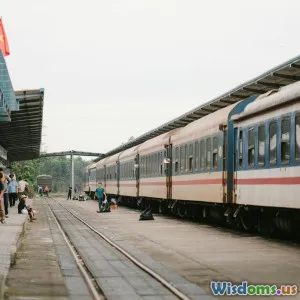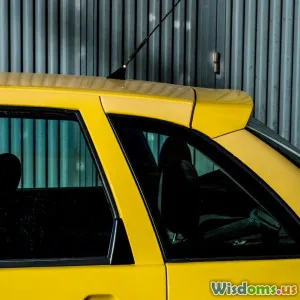
Shared Mobility vs Traditional Transit Who Wins
9 min read An insightful analysis comparing shared mobility and traditional transit’s impacts on urban transport sustainability and convenience. (0 Reviews)
Shared Mobility vs Traditional Transit: Who Wins?
In cityscapes around the world, the battle for our commutes is intensifying. As urban populations surge and conventional transit systems face challenges, shared mobility emerges as both a complement and competitor. But which mode truly delivers better mobility solutions: shared mobility services like bike-shares and ride-hailing or the stalwart conventional transit such as buses, trams, and subways? This engaging exploration examines their dynamics with data-driven insights, real-world examples, and informed perspectives.
Introduction: A New Era in Urban Mobility
Urban mobility is no longer a binary choice between owning a private vehicle and hopping on a traditional bus or train. The arrival of shared mobility—the solutions that allow users to share vehicles including bikes, scooters, cars, and rides—has disrupted how people navigate cities. According to McKinsey, shared mobility could cover up to 40% of city transportation needs by 2030.
Traditional transit systems, designed for mass convenience and sustainability, face ridership stagnations in many cities during the pandemic recovery. Meanwhile, shared options promised flexibility, speed, and reduced ownership costs, sparking a fundamental question:
Are shared mobility services supplanting traditional transit, or can they coexist and complement? Which ultimately wins?
Understanding the Players
Traditional Transit: Backbone of Urban Mobility
Traditional transit encompasses fixed-route buses, trams, metros, and commuter rails operated by municipal or regional transit authorities. Key strengths include:
- High-capacity service: E.g., New York City subway transports roughly 5.5 million riders on an average weekday.
- Lower per-passenger emissions: Public transport typically produces far fewer emissions per passenger kilometer than cars.
- Affordability and accessibility: Urban transit is essential for low-income populations.
However, these systems also contend with rigid schedules, often complex route networks, and in some places, aging infrastructure.
Shared Mobility: Flexible, On-Demand, and Diverse
Shared mobility models vary widely:
- Bike and scooter sharing: Cities like Paris and Washington D.C. boast thousands of dockless or station-based vehicles.
- Car-sharing services (e.g., Zipcar).
- Ride-hailing platforms (Uber, Lyft).
Advantages include convenience, personalization, and sometimes lower waiting times. Their rapid innovations respond to dynamic user preferences — for instance, electric scooter services entered several cities within months to meet short-distance demands.
But concerns about safety, regulation, and environmental impact persist. For example, studies in cities like Seattle revealed that many rideshares add 'deadheading' miles, increasing traffic congestion.
Comparative Analysis
Efficiency & Speed
- Shared Mobility: Especially for first and last-mile connectivity, shared bikes or scooters help close the gap between transit stops and final destinations, dramatically improving “end-to-end” travel times. Ride-hailing offers door-to-door travel without transfers.
- Traditional Transit: Provides greater speed on fixed corridors, and heavy rail can avoid traffic through dedicated subways.
Data Insight: A 2020 UITP (International Association of Public Transport) study observed that integrating shared bikes with metro systems reduced average trip times by up to 15%.
Environmental Impact
- Traditional Transit creates economies of scale, lowering emissions per passenger-kilometer, with many systems switching to electrification—for example, the London Underground is powered increasingly by renewable sources.
- Shared Mobility's environmental benefit varies. Bike-shares are zero emissions during use; however, scooter lifecycles and manufacturing emissions can narrow benefits. Ride-hailing's vehicle miles traveled sometimes increase urban congestion, offsetting gains.
Example: In Los Angeles, replacing a ride-hailing trip with transit significantly cuts carbon footprint—25 pounds of CO2 saved per trip, on average.
Accessibility & Equity
- Traditional transit remains essential for underserved populations, offering affordable fares and accessibility features for people with disabilities.
- Shared Mobility often faces criticism for uneven distribution—industry data shows most shared bikes and scooters concentrate in affluent neighborhoods, limiting access.
Programs like 'CaBi Plus' in Washington D.C. subsidize low-income riders, signaling efforts to mitigate equity issues.
Cost & Affordability
- Transit systems typically maintain low cost-per-trip, subsidized by governments—for example, Chicago’s average bus fare is about $2.
- Shared Mobility costs vary widely; short bike-share rides may cost just a dollar, but frequent ride-hailing fares can add up, especially in high-demand periods.
Transparent pricing was crucial during COVID-19, as transit agencies sought to retain ridership amid health concerns.
User Experience and Convenience
User experience remains subjective but increasingly essential.
- Shared mobility apps provide seamless booking, flexible schedules, and real-time tracking. Uber’s monthly rides exceed 1 billion, a testament to user adoption.
- Transit agencies invest heavily into real-time information and integrating contactless payments. Cities like Singapore use combined trip planners merging buses, trains, and bike-shares.
Pandemic Impact: A Catalyst for Change
The 2020 pandemic reshaped transit ridership globally, accelerating shared mobility adoption:
- New York City lost up to 90% of its transit riders early in COVID-19 but saw surge in bike-share demand.
- Many shared ride providers enhanced protocols and promoted solo rides, adapting faster than fixed-route transit operators.
But urban planners caution: reaching pre-pandemic transit levels is key for sustainable environmental goals.
Synergy and Future Outlook
Rather than declaring a sole winner, many experts argue the future lies in integration.
Case Study: Helsinki’s Mobility as a Service (MaaS)
Helsinki offers a subscription where users access buses, trains, ride-sharing, bikes, and taxis through one app. The model increased public transport ridership by 10% and decreased private car use.
Technology as an Enabler
Emerging tech such as AI-driven route optimization, autonomous shuttles, and dynamic pricing seeks to harmonize both shared mobility and transit systems.
Policy and Planning Implications
Regulations must balance innovation with equity, congestion, and environmental impacts. For instance:
- Cities limiting ride-hailing fleet sizes while investing transit service frequency.
- Incentives for electric shared vehicle fleets.
Conclusion: Who Wins?
The answer isn’t binary but nuanced. Shared mobility excels in flexibility, personalization, and filling transit gaps, while traditional transit offers unmatched capacity, environmental benefits, and broad accessibility.
In a world striving for sustainable, inclusive, and efficient urban transport, a hybrid model integrating traditional and shared mobility services wins—leveraging the strengths of both to improve quality of life and reduce dependence on private vehicles.
Investing in smart infrastructure, equitable access, and technology platforms will determine the ultimate champions of our urban mobility future.
For commuters, policymakers, and urban developers alike, embracing this synergy opens the road to a more connected and sustainable world.
Rate the Post
User Reviews
Popular Posts


















